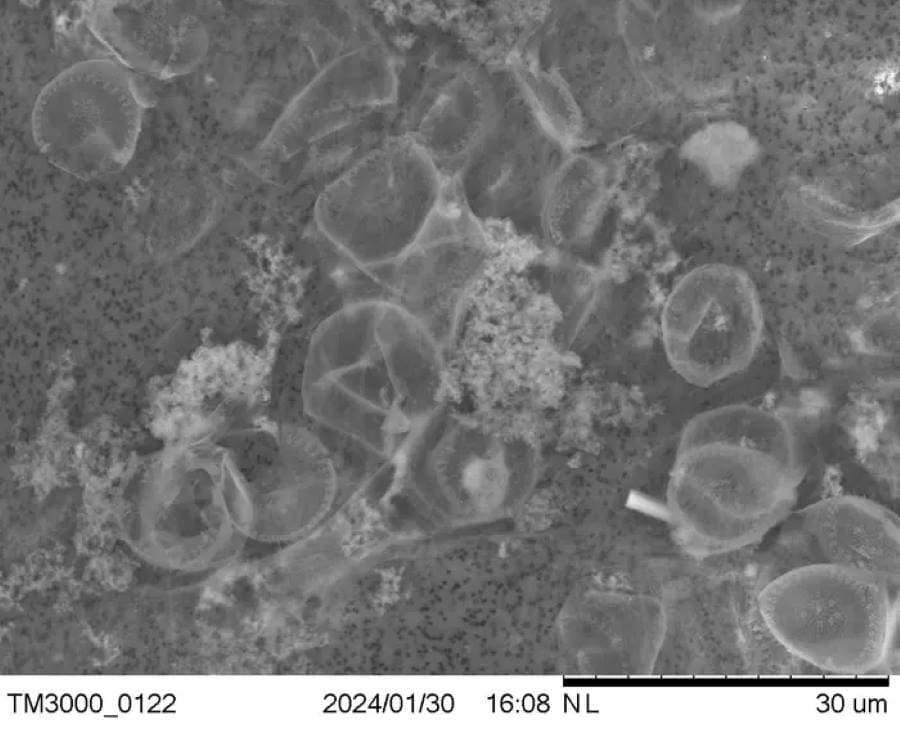Harnessing the natural appetites of zooplankton, researchers at Dartmouth College have developed an innovative way to accelerate the ocean’s capacity to store carbon, potentially advancing the fight against climate change.

By using clay dust to manipulate the ocean’s biological pump, this new method helps turn atmospheric carbon dioxide into food for zooplankton, which later expel it into the deep sea as carbon-rich feces.
The concept builds on the ocean’s natural carbon cycle, where algal blooms on the water’s surface capture carbon dioxide and convert it into organic material. After these blooms die, much of this captured carbon is released back into the atmosphere as marine bacteria break down the particulates.
Mukul Sharma, professor of earth sciences at Dartmouth and the study’s corresponding author, explains how clay dust offers a solution. “The novelty of our method is using clay to make the biological pump more efficient—the zooplankton generate clay-laden poops that sink faster,” says Sharma, who presented the findings today (Dec. 10, 2024) at the American Geophysical Union annual conference.
The paper was published in Scientific Reports, a journal from Nature.
Spraying clay dust on the surface of the ocean during algae blooms creates tiny, sticky pellets that trap organic carbon. These pellets, or flocs, are consumed by zooplankton and later expelled at greater depths, where the carbon can remain stored for millennia.
Laboratory experiments conducted during a 2023 algae bloom in the Gulf of Maine showed that clay-treated water could sequester up to 50% of the carbon that would otherwise be released into the atmosphere. Additionally, the treatment reduced carbon-releasing bacteria while increasing the concentration of organic particles by tenfold.
This process transforms the natural phenomenon known as marine snow, a steady rain of organic matter, minerals, and dead organisms that sinks into the deep ocean. By binding clay with organic carbon, the researchers accelerated marine snow formation, enhancing its role in the biological pump.
Sharma notes: “We’re creating marine snow that can bury carbon at a much greater speed by specifically attaching to a mixture of clay minerals.”
Zooplankton play a vital role in this system. Their nightly migration to the ocean’s surface, known as diel vertical migration, sees trillions of these tiny creatures feed on nutrient-rich particles near the surface before returning to the depths by day. Along with consuming clay-carbon flocs, they expedite carbon transport through their waste. This active transport mechanism shaves days off the time it takes carbon to sink into the deep sea.

Field tests are planned off the coast of Southern California, where Sharma’s team will spray clay onto phytoplankton blooms using aircraft. Sensors at various depths will monitor how effectively zooplankton species ingest and expel carbon-rich flocs. Sharma emphasizes the need for precise testing: “It is very important to find the right oceanographic setting to do this work. You cannot go around willy-nilly dumping clay everywhere.”
This collaborative effort included contributions from researchers at institutions such as Bigelow Laboratory for Ocean Sciences, Sorbonne University, and Gothenburg University. The study’s co-authors explored diverse aspects, from the behavior of marine bacteria to the genetic analysis of seawater samples, ensuring a comprehensive approach to this novel carbon storage method.
***
The study’s first authors are Diksha Sharma, a postdoctoral researcher in the Sharma lab who is now a Marie Curie Fellow at Sorbonne University in Paris, and Vignesh G. Menon, who received his master’s degree from Dartmouth this year and is now a PhD student at Gothenburg University in Sweden.
Additional authors include George O’Toole, professor of microbiology and immunology in the Geisel School of Medicine, who oversaw the culturing and genetic analysis of bacteria in the seawater samples; Danielle Niu, who received her doctorate in earth sciences from Dartmouth and is now an assistant clinical professor at the University of Maryland; Eleanor Bates, now a PhD student at the University of Hawaii at Manoa; Annie Kandel, a former technician in Sharma’s lab; and Erik Zinser, an associate professor of microbiology at the University of Tennessee focusing on marine bacteria; David Fields, a senior research scientist and zooplankton ecologist at the Bigelow Laboratory for Ocean Sciences in Maine; Manasi Desai, a former technician in Sharma’s lab, is now a technician in the Fields lab.
Journal Reference:
Sharma, D., Menon, V.G., Desai, M. et al. ‘Organoclay flocculation as a pathway to export carbon from the sea surface’, Scientific Reports 14, 28863 (2024). DOI: 10.1038/s41598-024-79912-z
Article Source:
Press Release/Material by Dartmouth College
Featured image credit: Mukul Sharma | Dartmouth College




